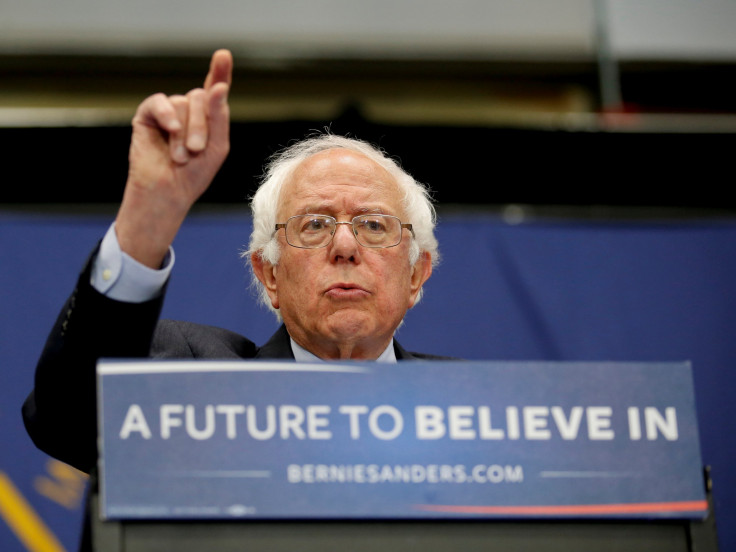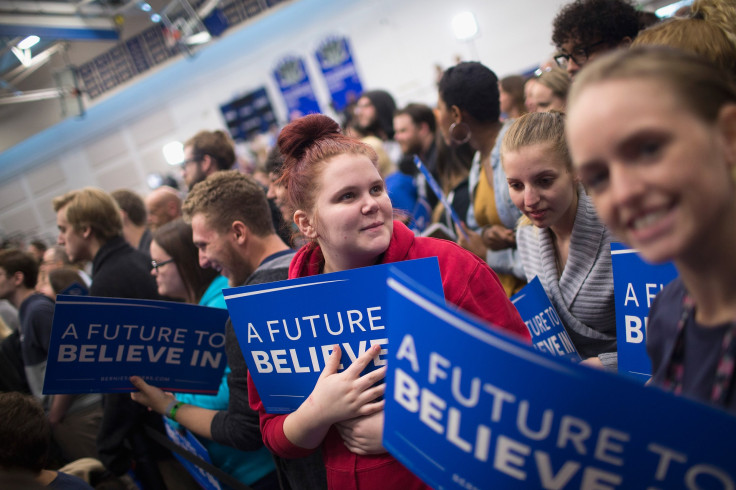A Bernie Sanders Comeback In Indiana? Possible Upset Predicted By Economic Woes Like Those In Wisconsin And Michigan

From here on out, pretty much every state presidential primary election in the Democratic race will be a matter of life and death for Bernie Sanders’ campaign. The left-wing upstart has been hanging on ever since he got clobbered by front-runner Hillary Clinton in the Northeast last week. Now he appears less focused on securing an outright delegate lead than he is on entering the Democratic National Convention in July with as slim a deficit as possible.
Lucky for Sanders, then, that Indiana will be the first place to hold a primary since the routs in Connecticut, Delaware, Maryland and Pennsylvania last week. If there’s any place where he can regain his footing, it’s the Hoosier State. A victory there Tuesday night wouldn’t make Sanders any more likely to win the nomination — but it could give him more clout at the convention, where he reportedly intends to fight for a more-progressive Democratic Party platform.
That’s because Indiana has some important features in common with Michigan, the site of the Democratic primary season’s most stunning upset. Michigan is where Sanders confounded the pollsters and recorded a decisive victory almost two months ago. His campaign staff has reason to hope for a similar performance in Indiana.

It all comes down to themes Sanders has sounded on the campaign trail and will likely want better represented in the Democratic platform: the shrinking of the middle class, the economic devastation wrought by free trade agreements and the decay of the American labor movement. Like Michigan, Indiana perfectly embodies these themes. The question is whether the resulting voter anger will deliver Sanders another much-needed victory.
The forecasters say no. Most polls in Indiana have shown Clinton leading Sanders by single-digit percentage points, although the latest NBC News/Wall Street Journal/Marist survey found the U.S. senator from Vermont within striking distance of the former U.S. secretary of state. Basing its forecasts on an analysis of endorsements and polls, the website FiveThirtyEight has projected Clinton has a 91 percent chance of winning Indiana. However, FiveThirtyEight also gave Clinton a better than 99 percent chance of winning the Michigan primary. That’s why it’s called an upset.
The polls are a good reason to believe Sanders is a long shot in Indiana, but the state has a few key demographic indicators working in his favor. For starters, Indiana is proportionally whiter than the U.S. as a whole: The Census Bureau estimated that 86 percent of Indiana residents were white in 2014, as opposed to 77 percent of Americans overall. While Sanders has made some inroads with the black community since he first launched his candidacy, he still tends to do best in states with largely white populations.
More to the point, Indiana residents are subject to many of the same economic pressures that helped define the Michigan primary. Both Indiana and Michigan are Rust Belt states with declining manufacturing strongholds. Both states boast proud blue-collar labor movement traditions, which in recent years have been substantially undermined by conservative lawmakers. And both states, thanks to their reliance on factory work, have suffered as a result of free trade — perhaps more than anywhere else in the country.
In fact, the labor-friendly Economic Policy Institute reported in March that Indiana lost more jobs proportionally in 2015 due to the U.S. trade deficit with Pacific Rim countries than any other state except Michigan. The EPI was looking specifically at trade between the U.S. and the 11 other nations that have signed onto the impending free trade agreement known as the Trans-Pacific Partnership (TPP).
The EPI also found Michigan had lost 214,600 jobs since 2011 as a result of U.S. trade deficits with those 11 countries, adding up to 5.12 percent of employment in the state. No other state came anywhere near those losses, but Indiana got closest, losing 103,800 jobs over the same period. That loss amounted to 3.54 percent of employment in the state, the institute reported.
Commentators widely attributed the Sanders primary victory in Michigan to trade issues, although the full story may be somewhat more complicated. It is true Sanders is a more persistent critic of free trade than Clinton, whose husband enacted several major trade agreements while president. But an International Business Times analysis of election results and the EPI report found no correlation between the electoral map and the map of trade-induced job losses.
But if electoral districts did not go for Sanders because they had been directly harmed by free trade, the issue may still have had a more diffused effect on the primary. Those job losses may have engendered anxiety in working-class voters across-the-board, regardless of whether they themselves had experienced unemployment. Michigan exit polls found Democratic voters saying by a nearly 2-1 ratio that trade with other countries destroys jobs rather than creates them.
Trade isn’t the only issue that frustrated and unsettled the Democratic working-class electorate in Michigan. The state also passed an anti-union right-to-work law in 2013, when it became the 24th state to do so. Right-to-work laws prohibit unions from charging mandatory fees to the nonunion workers who they represent in many of their unionized shops. This creates a so-called free rider problem, according to labor advocates, because unions can be forced to represent countless workers in contract negotiations while receiving nothing in return.
When Michigan became a right-to-work state, it was a body blow to what has historically been one of the most powerful statewide labor movements in the country. In 2014, the first year after the adoption of the right-to-work law, the Michigan union membership rate dropped almost 2 percentage points.
Indiana’s right-to-work law preceded Michigan’s law by about a year. But the union membership rate in the former state has oscillated wildly since 2008, according to the U.S. Bureau of Labor Statistics. The overall trend has been downward, at a faster clip than union membership nationwide has declined.
In Michigan, the decline of organized labor fueled support for Sanders. The same thing happened in Wisconsin, where Sanders beat Clinton by 13 percentage points last month. Like Michigan, Wisconsin has historically been a center of union strength, but, beginning with the ascent of Republican Gov. Scott Walker in 2011, that state’s labor movement has been in a fight for its survival. Just weeks after taking office, Walker successfully had a law passed that constricted collective bargaining rights in the public sector. Then, after he weathered a union-led recall attempt in 2014, Walker signed legislation making Wisconsin a right-to-work state.

Primary results in Michigan and Wisconsin appear to show that Sanders does well in the traditional labor strongholds where unions are under siege. A surprise win in Indiana would confirm the trend.
What it wouldn’t do is substantially alter the outcome of the presidential-nomination race. Indiana isn’t a winner-take-all state, but even if Sanders magically won all 83 of its delegates and all nine of its superdelegates, he would still be 716 behind Clinton. A stroke of good fortune in Indiana could deliver him some additional leverage going into the convention, but not much else.
Still, that may be enough for his backers to claim a limited victory at the end of the primary season. If Sanders can plausibly argue that he leads a significant wing of the Democratic Party, he can press for platform additions such as a $15 minimum wage endorsement, a call for single-payer healthcare, and a denunciation of free trade agreements such as TPP. And if he were to win even a handful of those concessions, it would be an achievement — and economically distraught states such as Indiana would deserve a good portion of his campaign’s gratitude.
© Copyright IBTimes 2024. All rights reserved.






















